Implications of Electroacoustic Composition in an Intercultural Context
Negotiating cultural meanings and uses of timbre
Timbre, as a basic element of all music traditions, contributes to the formation of an identity of a music culture, both in the timbral uniqueness of a culture’s instrumental and vocal practices (e.g., when one music culture is compared to another), and in a culture’s system of beliefs, values and meanings that shape the timbral profile of these instrumental and vocal practices. When different music cultures interact, instruments, their timbres and associated meanings are assimilated and transformed in the new music culture. Consider the case of the ancient Persian instrument, the barbat. Over hundreds of years and thousands of miles, the barbat travelled in a linear fashion along Silk Road trade routes and was slowly assimilated into Chinese, Korean and Japanese music traditions as the pipa, bipa and biwa, respectively (Fig. 1). With these assimilations came the modification of the instrument’s shape and changes to the fret locations (reflecting scales of different cultures), tunings, performance practices (playing position and string attack techniques) and cultural functions. Each played a role in slowly transforming the timbral identity of the Persian barbat, as it assimilated from one culture to the next.

Modern-day intercultural interaction, by contrast, moves at a much faster pace, across distance and over time. Global methods of travel and digital communication allow for cultural leap-frogging in a geographically non-linear fashion from one location in the world to the next in a matter of hours or, in the case of the internet, seconds. The foundations of this phenomenon lie in the West’s global presence, in addition to its scientific and technological innovation. On the one hand, this situation holds potential for global communication that could foster new cultural interaction and collaboration. On the other hand, however, the potential also exists for the West-rooted ideals of innovation associated with technology to dominate the intercultural context and obscure the essential values and identities of other cultures involved in the exchange. Consider the Chinese pipa in the electroacoustic context: while the power of computers to transform any sound through a variety of electronic music techniques offers great creative potential to composers, it also has the power to transform the instrument’s sound to something beyond recognition. This not only obscures the identity of the instrument, but also potentially the identity of the culture as well.
Here we investigate the implications of timbral transformation in the context of intercultural electroacoustic composition. Forming a background to a discussion of current day intercultural electroacoustic composition is a brief consideration of the history of Western music’s interaction with different cultures and music traditions in the world, from the 15th century up through the present day. In the second section we look at what is meant by terms such as “intercultural” or “cross-cultural” composition in the 20th and 21st centuries and whether the hegemonic history of the non-European “other” in the West in the 15th through the 19th centuries persists today, or whether Western art music has “moved beyond” this paradigm. Then we briefly consider timbre in Chinese, Tuvan and Western music as a way to grasp the weight of cultural significance of timbre in each culture, as well as the comparative differences in meanings and use of timbre between the three. Finally we will look at intercultural electroacoustic composition in the context of Chinese and Western traditions through the presentation and brief discussion of the electroacoustic approach taken in designing and implementing software to extend natural guqin resonance in the author’s work, Twelve Landscape Views: III. Guqin, Saxophone, Electronics.
Interculturalism and Western Music
Histories of music traditions of the world consistently show us that intercultural interaction is a basic characteristic of human culture. The transformation already mentioned of barbat into pipa, bipa and biwa across the Asian continent can be complemented with other examples of regional music interculturalism, such as the Arab maqam scale system, which has been shared and transformed by Persian, Turkish and Central Asian cultures, or Chinese court music traditions that were adopted and transformed by Korean and Japanese cultures. Composer Béla Bartók commented on the significance of intercultural interaction in his 1942 essay “Race Purity in Music.” Bartók addresses the idea of “purity and impurity of the human race” in the context of early 1940s Europe and whether “purity of race should be preserved” (Bartók 1992, 29). Speaking from his years of experience studying folk music culture of Eastern Europe, he concluded that:
Contact with foreign material not only results in an exchange of melodies, but gives an impulse to the development of new styles… as a result of uninterrupted reciprocal influence upon the folk music of these peoples. There are an immense variety and wealth of melodies and melodic types. The “racial impurity” finally attained is definitely beneficial. (Bartók 1992, 30–31)
Although intercultural interactions are a common trait among adjacent music cultures, they also do not always occur with an equality of intention between the two cultures. Multiple factors can create a context for such exchange, including “social conditions, deliberate or forced migrations” and even “the results of war devastation… followed by colonization” (Bartók 1992, 31). In the context of Arab music culture, maqam spread in part due to the Muslim conquests, and the adoption of China’s Tang Dynasty court traditions took place in the context of a Korean and Japanese tribute state relationship with China (Beasley 1999, 23).
With the dawn of European maritime exploration in the 15th century, Portuguese and Spanish explorers initiated an era of intercultural interaction between Europe and the rest of the world with repercussions up through the present day. One key to understanding the nature of this intercultural interaction lies in the conception of European selfhood. Timothy Taylor explains that “interchangeability”, where inhabitants of cultures newly encountered by Europeans were all considered to be “similar” in the eyes of Europeans, along with a lack of detailed knowledge of these cultures, allowed Europeans of the 15th century onwards to define the people in these distant lands as a non-descript “other” and to feel free to depict them in whichever way they wished. This is one of the factors that led to the “other” imagined as “wild, cannibalistic, irrational, sexually ravenous, monstrous” (Taylor 2007, 20). Said’s concept of Orientalism reflects these views in the context of 19th-century Western colonialism, where the term “other” not only signifies the generalization of many different cultures across the Asian continent into a single imagined, exotic cultural type, but also reflects a strong attitude of superiority in Europeans toward these cultures (Said 1978, 10). At the centre of the judgment of the inferiority of the “other” was the supreme belief of the idea of Western progress and the assertion of “Western European superiority over ‘primitives’ whose cultures do not seem to possess a similar concept of progress, or who were later thought to be far behind in a progressive march toward industrial and scientific modernity” (Taylor 2007, 28). This was reflected not just in colonialist policies in foreign lands, but also the expression of these ideas by Europeans in Europe, including European artists.
In the visual arts, an example of this is seen in the 19th French painter Jean-Léon Gérôme’s “Snake Charmer” (1870), which depicts a naked young boy charming a snake for a group of passive older men. Linda Nochlin, in her analysis of the work, points out that “we are haunted by the absences in the painting… so conspicuous, that once we become aware of them, they begin to function as presences, in fact, as certain kinds of a certain kind of conceptual deprivation” (Nochlin 1987, 35). She points to the absence of time in the static representation of decaying architecture and passivity of Egyptian men, as if the culture were stuck in an ancient and backward existence. Through realist technique, she also points to the absence of the artist and the work as a creation, as the work seems to portray the image as a reality of 19th Egyptian culture. In fact “Gerome seems to have relied on photographs” (Ibid., 37) to construct his image, not actually having physically been present in Egypt or familiar with the modern life of 19th Egyptian people. Similar exotic representations in European music of the late 19th exist as well. In Western Orientalist operas such as Verdi’s Aida (1871), there also exists an “Orientalized Egypt” created through an eroticized “Oriental female”, the reliance on the pseudo-archaeology of Egyptology and the use of “Oriental music… harmonic clichés… based on the flattening of the hypertonic” (Said 1993, 120–23). Collectively, such representations of Egyptian history, culture and music in Aida were largely generated by the imagination of Europeans and not based on actual Egyptian history, music or modern culture of that time (Ibid., 124–27).
In 20th-century Western art music, Yayoi Uno Everett argues that “the repertory of art music has (since) moved beyond the Orientalist and exotic paradigms of cultural appropriation” (Everett 2004, 2). While there is truth in this statement, there is also precedent for identifying lingering elements of “otherness” that underlie interactions between composers of Western art music and non-Western music culture. Western composition in the 20th century has a great variety of composers and compositions that engage with traditions outside of the West, and the characteristics of these intercultural works vary depending both on location (e.g., United States vs. Europe) and time (early vs. late 20th century). From an early 20th-century perspective we can consider the example of Stravinsky, who drew heavily from his Russian musical heritage to form his compositional language. While Stravinsky’s compositions were praised as revolutionary, Russian roots of the music were ignored or denied. In reference to Stravinsky’s The Rite of Spring (1913), Richard Taruskin points out that “the influential analyses of The Rite by Messiaen and Boulez… concentrated solely on the technical innovations, while completely ignoring the matters of style” and that the composer himself “was increasingly at pains to dissociate his great ballet from any taint of folklorism” (Taruskin 1980, 505–506). As Taruskin shows in his thorough music analysis, The Rite of Spring and other earlier ballets such as Petruschka, were deeply rooted in Russian folk music. Yet the supreme importance of innovation in Western art music, coupled with a continued subordination of the non-Western “other”, marginalized the significance of the intercultural elements in these works.
In mid-20th century America, we encounter John Cage, who drew heavily on religious and philosophical ideas from different cultures on the Asian continent. Everett points out a special relationship that American experimentalists had with non-Western music, embracing it “as a form of social protest against the hegemony of European musical culture” (Everett 2004, 3). While Cage’s ideas were revolutionary in opening up Western music to an entirely new way of thinking about music, Cage’s engagement with cultures on the Asian continent and his conception of Asian traditions are generalized, often referring to Hindu, Zen Buddhist and other texts collectively as a singular “Oriental Philosophy” (Corbett 2000, 170). In Cage’s music, the related music traditions attached to these religions and philosophies are absent. Corbett calls this “conceptual Orientalism”: cultural ideas are taken and used, but disconnected from any music that functioned in the context of Hindu or Zen Buddhist traditions. This kind of cultural disassociation can be seen as a pattern among American artists and thinkers, as it also exists in the writings of 19th American transcendentalists Ralph Waldo Emerson and Henry David Thoreau. Both were enthralled for different periods of time with Hindu, Buddhist and Confucian texts, incorporating their philosophical and spiritual concepts into their own writing. However they only “sought inspiration and ignored ritualism and cultural context” (Versluis 1993, 80). In this way, “when religion is stripped of its cultural and practical implications, rendered as merely ethical strictures and ‘abandonment to the Invisible’, it becomes a literary tradition” (Ibid., 78). Thus, in the case of Cage, there is a certain lack of cultural musical context that resonates a Western sense of “otherness”.
This examination of the history of the West’s interaction with different music cultures in the world provides an important foundation when considering the types of cultural interaction by composers of Western art music, and whether or not their work transcended Western Orientalist and exoticist patterns. Yayoi Uno Everett’s 2004 article, “Intercultural Synthesis in Postwar Western Art Music,” uses the term “intercultural” once in the title, but uses the terms “crossover,” “cross-fertilization” and “cross-cultural” throughout the rest of the article. While parsing subtle differences of these words may seem pedantic, the meanings of the prefixes “cross-“ (meaning the movement from one location to the next) and “inter-“ (meaning between two things) does change the sense of intention by composer or expectation of an audience labelled as such. The former suggests bringing something from one music tradition into the context of another tradition, while the latter suggests a mutual meeting point for elements of both music cultures in a new space not situated in or dominated by either tradition. This difference in meaning that comes with these word usages actually seems built into in a three-tiered taxonomy created by Everett (although it is not clear if this was intended) to classify different types of integration of music resources in a bi-cultural composition. While not explicitly stated by Everett, the contrast implies a hierarchy in the taxonomy, outlining an increasing depth of integration moving from a borrowed “cross-cultural” context to an in-between “inter-cultural” integration (Everett 2004, 15–19):
- Transference: Asian cultural resources are borrowed within a predominantly Western musical context.
- Syncretism: Asian and Western musical resources are merged procedurally.
- Synthesis: works that effectively transform the cultural idioms and resources into a hybrid entity (so they are no longer discernible as separable elements).
In this sense, the “synthesis” category seems to “move beyond” contexts where one culture dominates another. Such a deep integration of bi-cultural resources also implies that a composer would need to be more or less equally trained and experienced in the two music traditions in order to achieve such synthesis. This would mean the composer would be familiar not just with the musical material (melodies, rhythms, instruments, forms, etc.) but also the cultural context (including religion, ritual, etc.) in which the music functioned, perhaps even implying an extended stay in a geographic location to internalize the tradition from within the originating culture.
Music Timbre and Cultural Meaning
The previous sections were meant to situate a discussion on culture and timbre in the electroacoustic context within a broader historical perspective, in order to illuminate underlying historical patterns between the West and non-Western cultures, as well as to better define the idea of an intercultural composition in the present day. Before discussing music timbre and intercultural composition in the electroacoustic context, we will briefly compare and contrast timbre and meaning in Chinese, Tuvan and Western culture in order to develop a better feel for the weight of significance in meaning that timbre has in each these different cultures.
Timbre in Chinese Music
The origins of the significance of timbre in Chinese music has direct ties back to origin myths in China’s prehistory and the yin-yang duality expressed in the creation figures Fuxi (male) and Nüwa (female). This duality set up the concept of balance as a goal of Chinese society. Balance in society in the early Zhou Dynasty (1046–256 BC) was achieved through ritual-sacrificial ceremonies involving the use of pitches split up between two ascending and descending whole tone scales that when performed together in ritual, “symbolized the perfect balance of the binary opposition, thus creating harmony in the universal order” (Liang 1985, 57). In this context the “bayin” (eight sounds) system was created, which classified instruments according their material (metal, stone, skin, gourd, bamboo, wood, silk, earth) and the timbral qualities of each material. This symbolized a close association between sound and the natural world, as each instrument was selected to be performed in different seasons based on environmental conditions for the materials to vibrate and resonate in the most optimal way: bamboo in spring, metal or stone in winter. This system remained a remarkably stable foundation for Chinese music for over 3500 years. This is evidenced in the historically recent Ming and Qing Dynasty classifications of regional folk instrumental traditions based on their timbre (Northern “blowing and hitting” music using metal and skin percussion and Southern “silk and bamboo” music using bamboo flutes and silk stringed instruments), and in the treatise on guqin technique of the last 2000 years, where fingering techniques are discussed in relation to their timbral effect. In the guqin tradition, timbre took on especially deep and personal spiritual meanings connected with nature, the universe and one’s moral centre. In relation to the Confucian tradition, the Chinese literati scholar pursued expression in guqin performance through the different timbre-focused techniques as a way to cultivate himself to be a morally upstanding man in society. In the Daoist context, the literati scholar would play guqin to reconnect himself to nature and the universe. Guqin compositions such as Geese Descending on a Sandy Bank or Flowing Water give a programmatic account of sound in the natural landscape, which helps to link the guqin sound to the natural world for both performers and listeners.
Timbre in Tuvan Music
The importance of timbre in Tuvan music is centred on the spiritual practice of “sound mimesis: the use of sound to represent and interact with the natural environment and the living creatures that inhabit it” (Levin 2006, 74). In Tuvan culture, it is believed that there are many spirit-masters that inhabit the natural landscape, and in order to live amongst them in peace, one has to make offerings to them. Algysh, or praise songs, are sung using a throat singing technique that is meant to mimic elements in nature’s soundscape such as rivers, wind or birds. There are no words in throat singing, just “vocalizations consisting of reinforced harmonics [that imitate] sounds produced by the places or beings in which the spirit-masters dwell” (Ibid., 28–29). This timbral variation was no self-created music but a music taught to Tuvans by listening and imitating nature’s sounds. Tolya Kullar, a Tuvan throat singer, explained the practice to ethnomusicologist Theodor Levin: “In the old days, herders used to sit by a stream and throat-sing…. The stream itself showed them how to sing [and how to listen]” (Ibid., 27). This mimesis is, however, more than simple-minded imitation. To Tuvan listeners of borbangnaydr, or throat singing, there is an immediacy to the imitation within the landscape in which they stand that binds the singer spiritually to the natural world. throat singing is heard metaphorically as voices that “are the sonic embodiment of landscapes, birds and animals along with the spirits that inhabit them [and are] not just a figurative way of depicting flowing water, but imbued with craft and the sensibility open to æsthetic critique. Simply put, it is art” (Ibid., 75–77). In both Tuvan throat singing and Chinese guqin music, the desire to depict sounds heard in the natural world (e.g., the guqin work “flowing water” and Tuvan throat singing mimesis of the sound of flowing water) as a bond between humans and nature represents a strong a spiritual value for music timbre.
Timbre in Western Art Music
There is great value placed on science, technology and innovation in Western culture. While scientific inquiry into the nature of acoustics and complex tones begins in the West with the study of vibrations of a string by Pythagoras in the sixth century BC, it would not be until the 19th that the nature of timbre and the complex tone would be more thoroughly analysed and theorized in the works of Joseph Fourier (Théorie analytique de la chaleur, 1822) and Hermann von Helmholtz (Die Lehre von den Tonempfindungen, 1885). Inquiry into the æsthetic value and meaning of music timbre arose earlier in 18th century with early Enlightenment writings of Herder, Kant and Rameau, reflecting on human emotion and the senses and how objects (e.g., music instruments) functioned as “extensions of the senses” (Dolan 2013, 72). Emily Dolan points to an example in Kant’s own reflections on tone colour in sight and sound, and the æsthetics of judgment related to such sensations:
[W]e cannot say with certainty whether a color or a tone (sound) is merely an agreeable sensation or whether it is of itself already a beautiful play of [component] sensations and as such carries with it, as we judge it æsthetically, a liking for its form. Just consider the rapidity of the vibration of light, in the case of tones, of the air, which probably far exceeds all our ability to judge directly in perception the ratio in the temporal division [produced] by these vibrations. (Kant 1987,194)
Timbre as a music element of increased importance and focus in Western composition is most often associated with Romantic era composers, beginning with Hector Berlioz and his treatise Grand traité d’instrumentation et d’orchestration modernes (1844). However, Dolan argues in her book, Haydn and the Technologies of Timbre, that there were significant advances made in Haydn’s development of sophisticated orchestral strategies in his Paris and London symphonies of the 1780s and 1790s, and these advancements were due in part to the technological development of instruments available to Haydn as a composer (Dolan 2013, 22). In addition, Roberts, in his dissertation, Origins of a Modern Orchestral Style: The evolution of timbre, gesture, phrase and form in the slow movements of Haydn’s early symphonies (1758–1774), reveals through close analysis of formal structures and orchestral strategies of symphonies of the 1760s and 1770s, the beginnings of this evolutionary process of Haydn’s use of orchestration: from orchestration applied after most of the compositional process was completed (using generic orchestral formulæ) to piece-specific orchestral strategies, with innovative orchestration becoming a part of the primary composition process and used to clarify layers of musical texture and articulate larger formal structures (Roberts 2008, 29). Here orchestral invention was facilitated by new advancements in Haydn’s harmonic language, which expanded phrase lengths and opened up new temporal and registral space. Thus, the concepts and meanings of timbre that exist in the Western world today (especially in the context of modern acoustic and electroacoustic art music) derive from on-going compositional innovation, scientific discovery and technological innovation stretching back to the 18th century, as well as continual philosophical and æsthetic grappling with the meanings of these discoveries and innovations.
Timbral Transformation in Intercultural Electroacoustic Music Contexts
These accounts of timbre in Chinese, Tuvan and Western music culture reveal not only the differences in the meanings and uses of timbre in each culture, but also the depth to which these meanings and uses define cultures broadly, beyond the boundaries of the music traditions. Chinese and Tuvan cultures place a high spiritual value on music timbre (in their capacity to connect music sound and emotion to the natural world and universe), and timbral transformation in Chinese guqin music or Tuvan throat singing, for example, functions within the idiomatic boundaries of these performance practices to achieve this spiritual connection. In Western acoustic and electroacoustic art music, timbral transformation occurs within a cultural context that places high value on the act of innovation itself. Of course, this innovation is not devoid of emotion or meaning, but expression happens through individual innovation and the goal of original work is top priority. Thus, in the context where a bi-cultural integration of Tuvan or Chinese music with Western music is attempted, the intention to work with timbre interculturally brings up discrepancies in the meanings and uses of timbre between the two cultures. With the power of Western technology to create immediate transformation, there is a risk of a cultural dominance in electroacoustic music, in its power to easily obscure Chinese or Tuvan cultural identity through electronic manipulation and transformation of instrumental or vocal sound.
Capturing the weight of significance in musical meanings of two music cultures within the same work is no easy task. As Everett’s third category “synthesis” suggests, it is a matter of bringing the elements to a meeting point of integration somewhere between the two traditions, so that they have a chance to interact in some kind of common ground, where neither cultural context dominates the other. Part of the craft in forming such a work involves being capable of listening, at the same time, with two different sets of ears, to the two different root traditions in their original form. The capacity to do this depends at least in part on having enough first-hand experience with the music traditions, ideally from having spent enough time studying and/or performing in each tradition so that musical instincts developed within those traditions exist on a second nature, intuitive level. This invites a level of engagement of the two traditions where just one tradition is never always leading the compositional effort, but rather there is either a balance between the two or a constant back-and-forth leading by the intuitions of one tradition, then the other. While there is ample capacity to pursue this in the acoustic realm, the electroacoustic realm offers a unique opportunity for intercultural composition because, although the technology originates from Western culture, the abstract electronic music space is a kind of blank canvas, capable of being filled with any music sound or material, be it Chinese, Tuvan, Western, etc. In this way, the electronic music realm provides a potential platform for the meeting points of different cultures, perhaps capable of being called a “virtual in-between space”. In the context of working in an intercultural electroacoustic context in with timbre, while technology and the drive to innovate is a cultural feature of the West, the application of technology can be applied to a context where the sonic world and connected meanings of Chinese or Tuvan culture take the lead in shaping the way in which technology is used to enhance and extend timbre and meaning from these cultural perspectives.
Expansion of Guqin Timbre and Resonance in “Twelve Landscape Views: III. Guqin, Saxophone, Electronics”
Turning now to my own work, I hope the preceding discussions can illuminate my approach to composing works for the guqin and Western instruments in the electroacoustic realm. The previous discussions reflect a prolonged period of thought, over a period of five years while studying guqin in China, about the deeper implications of integrating the Chinese guqin tradition with my own Western background in improvisation and composition. The intercultural links in Twelve Landscape Views: III. Guqin, Saxophone, Electronics (2014) are not solely within the realm of timbre and resonance, but reflect broader experiences in the study of Chinese and American æsthetics, as well as significant time spent exploring a bi-cultural type of improvisation on guqin. These explorations included the use of musical material from guqin compositions, influences from guqin improvisation from my teacher Li Xiangting, as well as influence from my own background in Western free improvisation, experimental music and composition. This closing section will review æsthetic meanings of timbre and resonance in the guqin tradition and my development of music software, meant to both extend guqin resonance in subtle ways and integrate the guqin world with my own world music experience in the West.
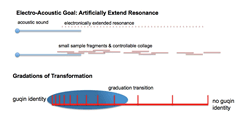
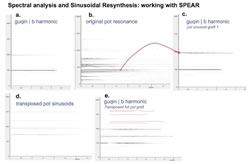

In the context of the Chinese guqin tradition, timbre and resonance play a significant role in the sonic, æsthetic and spiritual realms. Guqin, an instrument with a 3000-year continuous tradition was once a ritual instrument in Zhou dynasty (a part of the aforementioned Chinese cosmology rooted in the study of acoustics), but for the last two thousand or so years has been a solo tradition of the Confucian literati scholar, who used the performance of guqin works for Confucian and Daoist practices of self-cultivation. In guqin ideology, the sound of the instrument is closely connected with the natural world through Daoism. In the Daoist context, the scholar may play guqin to cultivate a personal connection to nature and the universe by allowing his zhi (直), or “intuition”, to come out creatively while interpreting a guqin composition. Human intuition is thought to be a source of knowledge guided by the larger rhythms and patterns in nature and the universe. Sound resonance in this context is interwoven in with emotional aspects of the tradition. The concept of qiyun (气韵), meaning an emotional “after feel” (in relation to the music-æsthetic experience of listening to guqin), merges with the concept yinyun (音韵), meaning “resonance in sound,” to form the concept qinyun (琴韵): a unification of sound, emotion and nature within the guqin tradition. The concept is conceptualized in a quote from guqin master Li Xiangting describing the meaning of Tang Dynasty poet Li Bai’s poem in describing guqin sound: “It is not the sound of each guqin note… the feeling comes from the resonance in the gaps between the pine trees” (Li 1989, 5).
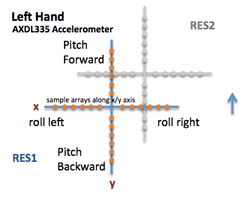
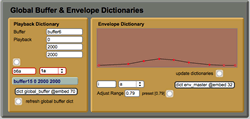

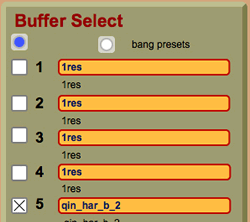

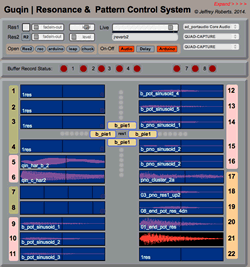
In Twelve Landscape Views, I draw on these sonic and æsthetic aspects of the guqin tradition in creating a sensor-interactive software programme meant to artificially extend the natural resonance of guqin and blend it with the saxophone sound. The ultimate goal in designing this software was to have a controllable electronic sound resonance range that went from sounding exactly like guqin acoustic resonance to gradually moving away from guqin’s sonic identity and eventually having no guqin acoustic identity (Fig. 2). While there are a number of options by which to generate an electronic “extended resonance”, I work with live and pre-sampled materials of an acoustic source, as this provided a baseline for having an electronic sound with little or no difference from the acoustic sound. This also provided an important link to my other work in found-object experimentation, where timbre, sound gesture and characteristics of resonance in acoustic sound form an important part of my Western composing and improvising practices. In addition to pre-sampled guqin sound, the pre-sample database also includes spectral components from the resonance of sampled found objects (e.g., bottles, pots, metal bar resonance, etc.) as well as samples of other resonant strings (e.g., piano). While there are spectrally “complete” samples of these instruments and objects in the database, much of the non-guqin samples are sinusoidal extractions from the found object or piano samples. These were analysed using Spear software and compared with the spectra of guqin pitch to either duplicate guqin resonance or extend it harmonically and timbrally. Of particular interest was to use the unique characteristics of amplitude variation in sinusoids of “strange vibrating bodies” such as cooking pots. These sinusoids, when shifted in pitch and grafted onto the spectra of a guqin note, allowed extended resonance to still sound perceptually close to guqin acoustic resonance, but also to give the sound a new and strange shimmer or microtonal fluctuation. From this incremental change, other samples in the database contain transformations that move increasingly further away from guqin sound. Video 1 provides examples of the experimental grafting process in Spear, along with recordings of the combinations.
To control this extended electronic resonance during performance, Max/MSP-based software is designed around the hardware architecture of an x/y/z-axis accelerometer chip (AXDL335) routed into the computer through a combined Arduino UNO and Xbee wireless setup. The x- and y-axis of the accelerometer represent four directions of hand motion: Roll Right and Roll Left on the x-axis, Pitch Fore and Pitch Back on the y-axis (Fig. 3). To each of these four directions are mapped six play objects, each of which is successively triggered by increasingly higher threshold numbers on a scale of 0–127. A series of data dictionaries using the dict object populates sample and playback information into the 6x4 array of play objects that are mapped to the four directions of the accelerometer’s x/y axis (Figs. 4a, b, c, d, e). This module is called RES1. This programmable design in the selection of sample combinations and the mapping of them onto the accelerometer meant that the extended resonance world could be hand constructed on a micro-level of detail. This was important because in each step of designing sample combinations I could control the extent to which combinations remained closer or further away from the original guqin sonic identity, as well as develop mappings that fit with the left-hand motions of guqin technique and provide hand motions that could become expressive when triggering the collages of sampled sounds. In order to create a greater range and density of extended resonance, I designed a second module (RES2) with another 6x4 array of play objects mapped to the same accelerometer. RES1 typically handles sampled guqin resonance and subtle extended resonance through grafted sinusoidal fragments, whereas RES2 handles resonance that is more distant from the guqin sound world, including pot, bottle and piano string resonance. Both are controlled with different volume pedalling, allowing them to independently fade in, fade out and blend. Figure 3 shows the mapping structure of the x/y axis on the accelerometer (i.e. RES1 and RES2) as well as some of the data interfaces for programming the sample and playback settings for the RES1 and RES2.






Videos 2–4 demonstrate this system in action, each demonstrating a different type of extended resonance, moving further and further away from natural guqin extended resonance.
Twelve Landscape Views: III. Guqin, Saxophone, Electronics employs these electroacoustic techniques in great timbral variety throughout the piece. In general, there is a timbral progression in the character of electronically extended resonance: starting with pure guqin extended resonance in opening minutes of the piece (Audio 1 at 0:25 and 0:39) and moving toward extended resonance increasingly distant from natural guqin sound (Audio 1, 2:59–3:22). As the work closes, extended guqin resonance moves back to pure guqin resonance.
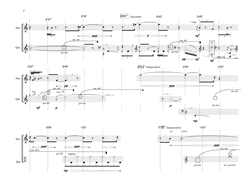
A second component of extended resonance occurs in the blending of live guqin and saxophone sound, with extended resonance involving guqin sound, saxophone sound and found object sound, the latter either in original acoustic form or extracted components of their spectra (Audio 1, 2:26–2:46). Here the attempt was made to integrate the timbral characters of the guqin and soprano saxophone through extended resonance. In this context, much effort was made to bring the saxophone into the quieter sound world of guqin.
Conclusion
Navigating between two music traditions in an intercultural work is a complex process of understanding each of the traditions, finding resonant points and working out a music language that can successfully blend the two. While my approach taken in Twelve Landscape Views is an attempt at intercultural integration on a deep level (perhaps moving towards Everett’s “synthesis” category), it is difficult to say whether the composition reached this intended goal. During the compositional process, while the intentions to integrate both traditions in a balanced way were a starting point, the creative instinct takes over and the piece moves to some extent in its own direction. The historical perspective presented here is not intended (either in regards to the creative work by myself or other composers) to be a measuring stick for success or failure of an intercultural work, but rather to suggest that a clearer understanding of the deeper historical and cultural forces at work can be presented to provide a foundation for intercultural creative work that moves beyond some stereotypes and/or assumptions imbued within the habit of historical thinking in the West. As well, while my own example of living and studying in two music traditions can help in working on an intuitive level with the rich and real detail of both music traditions, I don’t necessarily believe that “cultural authenticity” guarantees a good work of art. Ultimately it is within the individual composer, regardless of his or her cultural background, that will determine the uniqueness and success of an intercultural composition. Finally, through my own experiences in working with technology in an intercultural compositional context, I believe that such technology can provide a worthwhile platform for a more egalitarian meeting of music traditions, especially when it comes to working with elements of music such as instrumental timbre and resonance.
Bibliography
Bartók, Béla. “Race Purity in Music” (1942). In Béla Bartók: Essays. Edited by Benjamin Suchoff. Lincoln NE: University of Nebraska Press, 1992.
Beasley, William G. The Japanese Experience: A short history of Japan. Berkeley CA: University of California Press, 1999.
Corbett, John. “Experimental Oriental.” In Western Music and Its Others: Difference, representation and appropriation in music. Edited by Georgina Born and David Hesmondhalgh. Berkeley CA: University of California Press, 2000.
Dolan, Emily I. The Orchestral Revolution: Haydn and the technologies of timbre. Cambridge MA: Cambridge University Press, 2013.
Everett, Yayoi Uno, and Frederick Lau. “Intercultural Synthesis in Postwar Western Art Music: Historical contexts, perspectives and taxonomy.” In Locating East Asia in Western Art Music. Middletown CT: Wesleyan University Press, 2004.
Kant, Immanuel. Critique of Judgment. Trans. Werner S. Pluhar. Indianapolis IN: Hackett Publishing, 1987.
Levin, Theodore Craig. Where Rivers and Mountains Sing: Sound, music and nomadism in Tuva and beyond. Bloomington IN: Indiana University Press, 2006.
Li, Xiangting. Guqin jixingyanzou yishu yanjiu da gang (xia) [General Outline of Research on the Art of Guqin Improvisation (Part 2)]. Central Conservatory of Music Xuebao, 1989.
Nochlin, Linda. “The Imaginary Orient.” In Politics of Vision: Essays on nineteenth-century art and society. New York NY: Harper and Row, 1989.
Roberts, Jeffrey. Origins of a Modern Orchestral Style: The evolution of timbre, gesture, phrase and form in the slow movements of Haydn’s early symphonies (1758–1774). Ann Arbor MI: UMI Dissertations Publishing, 2008.
Said, Edward. “The Empire at Work: Verdi’s Aida.” In Culture and Imperialism. New York: Knopf, 1993.
_____. Orientalism. London: Routledge, 1978.
Taruskin, Richard. “Russian Folk Melodies in ‘The Rite of Spring’.” Journal of the American Musicological Society 33/3 (Autumn 1980), pp. 501–543.
Taylor, Timothy. Beyond Exoticism: Western music and the world. Durham NC: Duke University Press, 2007.
Versluis, Arthur. American Transcendentalism and Asian Religions. London: Oxford University Press, 1993.
Social top